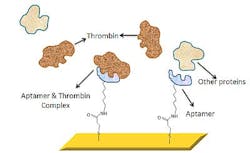Surface plasmon sensor enables low-cost, portable blood testing to speed diagnostics
A team of researchers from the University of Toledo (Toledo, Ohio) have recognized that blood tests are important diagnostic tools, yet have the setback of expensive, time-consuming testing procedures that require bulky, difficult-to-transport test equipment. To overcome these hurdles, the team developed a low-cost, portable technique that can quickly and reliably detect specific proteins in a sample of human blood, enabling early detection in medical sensing applications such as cancer and diabetes diagnosis.
Described in the Sept. 1 issue of Biomedical Optics Express, the system created by the researchers uses artificially created molecules called aptamersâcustom-made and commercially available short strands of nucleic acidâto latch on to free-floating proteins in the blood. In some ways, they mimic the natural behavior of antibodies found in the body because they connect to only one type of molecule. Specific aptamers can be used to search for target compounds ranging from small moleculesâsuch as drugs and dyesâto complex biological molecules such as enzymes, peptides, and proteins. Aptamers also have advantages over antibodies in clinical testing, as they are able to tolerate a wide range of pH and salt concentrations. They also have high heat stability, are easily synthesized, and are cost-efficient.
For their demonstration, the researchers chose thrombinânaturally occurring protein in humans that plays a role in clottingâand thrombin-binding aptamers. The researchers then affixed the aptamers to a sensor surface, in this case a glass slide coated with a nanoscale layer of gold. As the blood sample is applied to the testing surface, the aptamer and their corresponding proteins latched together.
Next, to determine whether or not the couples pairing was successful, the researchers used a real-time optical sensing technique known as surface plasmon resonance (SPR). A surface plasmon is a âvirtual particle,â created by the wave-motion of electrons on the surface of the sensor. If the protein is present and has bound to the aptamer, conditions for which resonance will occur at the gold layer will change. This resonance change is detected through a simple reflectance technique that is coupled to a linear detector.
The system's ability to monitor these conditions enables quantifying the amount of the target protein that is presentâeven at very low concentrations, says Brent D. Cameron with the department of bioengineering at the University of Toledo, one of the paperâs authors. It can identify unique aptamers for almost any given protein, making the technique specific and adaptable for any given application, he says. It also requires less-bulky optics, which is the key to its portability.
Aptamer sensors, according to the researchers, are also capable of being reversibly denatured, meaning they can easily release their target molecules, which makes them perfect receptors for biosensing applications.
âThe advantage of this surface plasmon sensor,â says Cameron, âis that it enabled us to demonstrate low sample consumption, high sensitivity, and fast response time.â The direct detection of blood proteins in this manner can benefit a number of scientific and clinical applications, such as monitoring diabetes, drug research, environmental monitoring, and cancer diagnosis.
For commercial use in medical diagnostics, according to Cameron, the technology is three to five years away, pending FDA procedures and filings. âThe time frame is very dependent on the target application area. We are currently in the procedure of determining suitable aptamers for a range of target proteins for both diabetic and cancer-related applications,â he says.
-----
Follow us on Twitter, 'like' us on Facebook, and join our group on LinkedIn
Follow OptoIQ on your iPhone; download the free app here.
Subscribe now to BioOptics World magazine; it's free!

